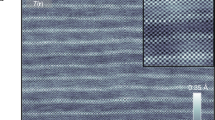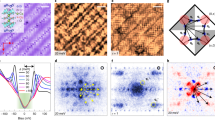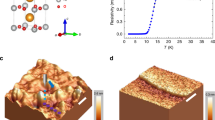Abstract
Arising from: J. Lee et al. Nature 442, 546–550 (2006)10.1038/nature04973
The study of bosonic modes that couple to the charge carriers is a key element in understanding superconductivity. Using atomic-resolution scanning-tunnelling microscopy (STM) to extract the spectrum of these modes in the high-temperature superconductor Bi2Sr2CaCu2O8+δ, Lee et al.1 find a mode whose frequency does not depend on doping but that changes on isotopic substitution of 16O with 18O. From this, they infer a role for lattice modes (phonons). However, examination of their data reveals a weaker, but distinct, feature that has all the characteristics of the magnetic excitation identified as the bosonic mode in other competing experiments2,3,4. We therefore suggest that the lattice mode seen by Lee et al.1 is not relevant to superconductivity and is due to inelastic tunnelling through the insulating oxide layer5.
This is a preview of subscription content, access via your institution
Access options
Subscribe to this journal
Receive 51 print issues and online access
$199.00 per year
only $3.90 per issue
Buy this article
- Purchase on Springer Link
- Instant access to full article PDF
Prices may be subject to local taxes which are calculated during checkout

Similar content being viewed by others
References
Lee, J. et al. Nature 442, 546–550 (2006).
Zasadzinski, J. F. et al. Phys. Rev. Lett. 87, 067005 (2001).
Zasadzinski, J. F. et al. Phys. Rev. Lett. 96, 017004 (2006).
Hwang, J., Timusk, T. & Gu, G. D. Nature 427, 714–717 (2004).
Pilgram, S., Rice, T. M. & Sigrist, M. Phys. Rev. Lett. 97, 117003 (2006).
McMillan, W. L. & Rowell, J. M. Phys. Rev. Lett. 14, 108–112 (1965).
Jaklevic, R. C. & Lambe, J. Phys. Rev. Lett. 17, 1139–1140 (1966).
Scalapino, D. J. Nature Phys. 2, 593–594 (2006).
Author information
Authors and Affiliations
Corresponding author
Ethics declarations
Competing interests
The authors declare no competing financial interests.
Rights and permissions
About this article
Cite this article
Hwang, J., Timusk, T. & Carbotte, J. Scanning-tunnelling spectra of cuprates. Nature 446, E3–E4 (2007). https://doi.org/10.1038/nature05709
Published:
Issue Date:
DOI: https://doi.org/10.1038/nature05709
This article is cited by
-
Superconducting coherence length of hole-doped cuprates obtained from electron–boson spectral density function
Scientific Reports (2021)
-
Close relationship between superconductivity and the bosonic mode in Ba0.6K0.4Fe2As2 and Na(Fe0.975Co0.025)As
Nature Physics (2013)
-
A distinct bosonic mode in an electron-doped high-transition-temperature superconductor
Nature (2007)
Comments
By submitting a comment you agree to abide by our Terms and Community Guidelines. If you find something abusive or that does not comply with our terms or guidelines please flag it as inappropriate.



